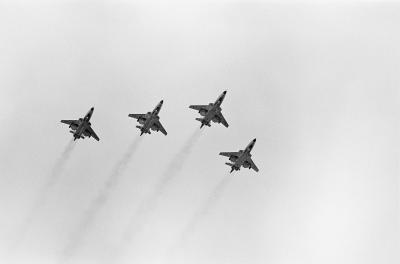
Aircraft must have appropriate navigation and fixed lights according to the FAA (Federal Aviation Administration), so they may operate in air traffic lanes with safety and comfort. Similar to the rules governing watercraft, navigation lights show the profile, direction and activity of a plane in flight. Navigation lights aid the pilot especially in low visibility and nighttime conditions, letting air traffic control personnel make visual contact and relay instructions in hazardous situations.
All aircraft will be equipped with steady lights attached permanently to each leading edge of the wing tip. The port side light, or left side facing the front of the plane, should be colored red. The starboard wing should have a green light affixed to the leading edge of the wing tip. They are to be displayed from sunset to sunrise, or when the sun has approached six degree below the horizon. Both lights should be visible for up to three miles. Orientation of the lights permits others planes to see flight direction.
A taillight should be affixed to the uppermost part of the tail fin on the plane. It is to be bright, white and detectable for up to three miles. The light should be in operation from sunrise to sunset, or when the sun has reached six degrees below the horizon. Some taillights, depending upon aircraft size, can be placed along the trailing edge of the horizontal tail or at the rear position of the fuselage. Orientation of the taillight aids in identifying the size of the aircraft and its direction of flight.
On larger commercial aircraft, such as airliners, two orange/red beacon lights are required. One light is to be affixed to the top of the fuselage and the other to the bottom. The lights should rotate and exhibit a flashing effect. The lights must be turned on before engine operation and after engine shutdown. The warning lights serve to warn airport workers that engines have been started and to remain clear.
For commercial jets and turbo prop airplanes, high-intensity strobe lights must be mounted on each wingtip, flashing white. Small planes, if applicable, are to have a strobe light in proximity to each port and starboard navigation lights on the wing tip. Some of the largest airliners come equipped with an additional strobe light located on the trailing edge of the plane. The strobe light attracts attention while the plane flies, and can also be seen during taxi on the runway.
Most large planes carry a bright white taxi light located on the front landing gear strut. The light remains on when the plane moves on the taxiway or during takeoff.
Bright, high-intensity landing lights allow increased visibility during the landing approach. During low visibility like ground fog or haze, landing lights provide that extra visibility for pilots, allowing them to see taxiway traffic or even runway obstructions. Their location varies according to plane brand, but most landing lights mount in the wing root, at the outer wing or somewhere near the front of the plane's nose.